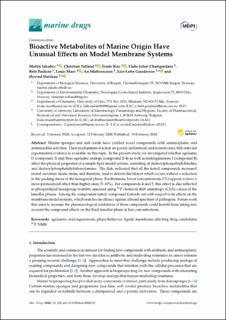| dc.contributor.author | Jakubec, Martin | |
| dc.contributor.author | Totland, Christian | |
| dc.contributor.author | Rise, Frode | |
| dc.contributor.author | Chamgordani, Elahe Jafari | |
| dc.contributor.author | Paulsen, Britt | |
| dc.contributor.author | Maes, Louis | |
| dc.contributor.author | Matheeussen, An | |
| dc.contributor.author | Gundersen, Lise-Lotte | |
| dc.contributor.author | Halskau, Øyvind | |
| dc.date.accessioned | 2021-04-16T11:00:50Z | |
| dc.date.available | 2021-04-16T11:00:50Z | |
| dc.date.created | 2020-03-31T13:35:06Z | |
| dc.date.issued | 2020 | |
| dc.identifier.issn | 1660-3397 | |
| dc.identifier.uri | https://hdl.handle.net/11250/2738115 | |
| dc.description.abstract | Marine sponges and soft corals have yielded novel compounds with antineoplastic and antimicrobial activities. Their mechanisms of action are poorly understood, and in most cases, little relevant experimental evidence is available on this topic. In the present study, we investigated whether agelasine D (compound 1) and three agelasine analogs (compound 2–4) as well as malonganenone J (compound 5), affect the physical properties of a simple lipid model system, consisting of dioleoylphospahtidylcholine and dioleoylphosphatidylethanolamine. The data indicated that all the tested compounds increased stored curvature elastic stress, and therefore, tend to deform the bilayer which occurs without a reduction in the packing stress of the hexagonal phase. Furthermore, lower concentrations (1%) appear to have a more pronounced effect than higher ones (5–10%). For compounds 4 and 5, this effect is also reflected in phospholipid headgroup mobility assessed using 31P chemical shift anisotropy (CSA) values of the lamellar phases. Among the compounds tested, compound 4 stands out with respect to its effects on the membrane model systems, which matches its efficacy against a broad spectrum of pathogens. Future work that aims to increase the pharmacological usefulness of these compounds could benefit from taking into account the compound effects on the fluid lamellar phase at low concentrations. | en_US |
| dc.language.iso | eng | en_US |
| dc.publisher | MDPI | en_US |
| dc.rights | Navngivelse 4.0 Internasjonal | * |
| dc.rights.uri | http://creativecommons.org/licenses/by/4.0/deed.no | * |
| dc.title | Bioactive Metabolites of Marine Origin Have Unusual Effects on Model Membrane Systems | en_US |
| dc.type | Journal article | en_US |
| dc.type | Peer reviewed | en_US |
| dc.description.version | publishedVersion | en_US |
| dc.rights.holder | Copyright 2020 by the authors. | en_US |
| dc.source.articlenumber | 125 | en_US |
| cristin.ispublished | true | |
| cristin.fulltext | original | |
| cristin.qualitycode | 1 | |
| dc.identifier.doi | 10.3390/md18020125 | |
| dc.identifier.cristin | 1804567 | |
| dc.source.journal | Marine Drugs | en_US |
| dc.source.40 | 18 | |
| dc.source.14 | 2 | |
| dc.relation.project | Norges forskningsråd: 240063 | en_US |
| dc.relation.project | Norges forskningsråd: 209330 | en_US |
| dc.identifier.citation | Marine Drugs. 2020, 18 (2), 125. | en_US |
| dc.source.volume | 18 | en_US |
| dc.source.issue | 2 | en_US |

